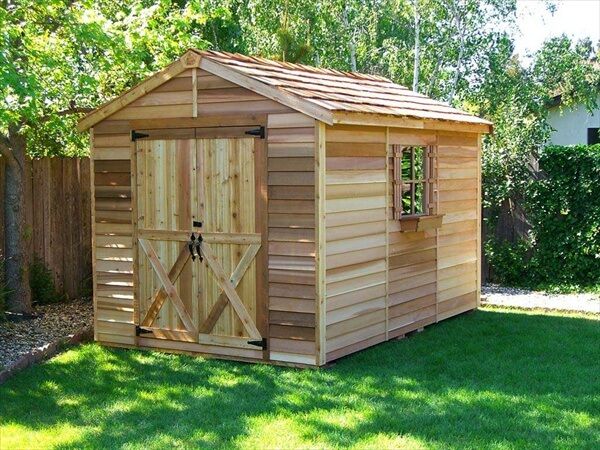Thursday, November 21, 2024
Download Free Pallet Shed Plans PDF: Build Your Own Backyard Shed

Download Free Pallet Shed Plans PDF: Build Your Own Backyard Shed
The allure of a backyard shed is undeniable. It offers invaluable extra storage space, a dedicated workshop area, or even a charming retreat, all within the convenience of one's property. However, the cost of professionally built sheds can be prohibitive. A resourceful and cost-effective alternative involves constructing a shed using reclaimed pallets. This article provides a comprehensive guide to building your own backyard pallet shed, including detailed planning, material sourcing, construction techniques, and safety considerations. While free downloadable PDF plans are readily available online, this guide will delve deeper into the intricacies of the project, ensuring a successful and durable outcome.
Phase 1: Planning and Design
Before embarking on the construction, meticulous planning is paramount. This phase involves determining the shed's size, location, desired features, and necessary materials. Careful consideration at this stage will prevent costly errors and ensure a structurally sound and aesthetically pleasing result.
Determining Shed Dimensions and Location
The dimensions of your pallet shed will depend on your storage needs and available space. Consider the types and quantities of items you intend to store. Accurate measurements are crucial. Sketch a detailed plan, indicating the shed's length, width, and height. Choose a location that is level, accessible, and complies with local building regulations. Factors to consider include proximity to utilities, drainage, and sunlight exposure.
Choosing Pallet Types and Assessing Their Condition
The quality of the pallets significantly impacts the shed's durability. Select pallets constructed from strong, untreated wood. Avoid pallets showing significant signs of rot, insect infestation, or damage. Inspect each pallet carefully for loose nails, broken boards, or other structural weaknesses. Prioritize pallets of consistent dimensions for easier construction.
Essential Tools and Materials List
Assembling a comprehensive list of tools and materials is crucial to ensure a smooth construction process. The list should include:
- Pallets: The quantity will depend on the shed's size and design.
- Measuring tape and level: Essential for accurate measurements and ensuring a level foundation.
- Hammer and crowbar: For dismantling and assembling pallets.
- Screws and nails: Choose exterior-grade fasteners for durability.
- Drill and screwdriver bits: For efficient fastening.
- Saw: For cutting pallets to size.
- Safety glasses and gloves: Essential for protecting against injuries.
- Post-hole digger or shovel: For creating foundation supports (optional but recommended).
- Concrete mix (optional): For setting foundation supports.
- Wood preservative and sealant: To protect the wood from the elements.
- Roofing material: Tar paper, corrugated metal, or recycled materials are suitable options.
Phase 2: Construction Process
This phase involves the actual building of the shed. This is a hands-on process requiring careful attention to detail and adherence to safety protocols. The specific steps will vary depending on the chosen plan, but general principles remain consistent.
Foundation Preparation
While not strictly necessary for smaller sheds, a foundation provides stability and longevity. A simple approach involves setting concrete piers or using pressure-treated lumber as footings. Ensure the foundation is level before proceeding to the next steps.
Wall Construction
Begin by disassembling the pallets, removing any loose nails or damaged wood. Construct the walls using the reclaimed pallet wood, ensuring the structure is square and plumb. Use screws or nails to secure the pallets together. Consider adding vertical supports for added strength, particularly for taller sheds. Proper bracing is essential to prevent warping and maintain structural integrity.
Roof Construction
The roof design should complement the shed's size and style. A simple gable roof is a common and relatively easy-to-construct option. Ensure sufficient overhang to protect the walls from rain. Use strong, weather-resistant roofing material. Proper sealing around the roof edges is crucial to prevent water leakage.
Door and Window Installation (Optional)
If desired, incorporate a door and windows into the shed's design. Ensure the door is securely fastened and properly sealed to prevent drafts and unwanted entry. Windows can add natural light and ventilation. Use appropriate hardware and sealing materials.
Phase 3: Finishing Touches and Maintenance
Once the shed's structure is complete, apply a wood preservative and sealant to protect the wood from moisture damage and insect infestation. This will extend the shed's lifespan and enhance its aesthetic appeal. Consider adding a decorative element, such as paint or stain, to personalize the shed's appearance.
Regular Maintenance
Regular maintenance is essential to ensure the longevity of your pallet shed. Inspect the structure periodically for any signs of damage or deterioration. Address any issues promptly to prevent further problems. Re-apply sealant as needed to maintain protection against the elements.
Safety Considerations
Safety should be prioritized throughout the entire construction process. Always wear appropriate personal protective equipment (PPE), including safety glasses and gloves. Use caution when working with sharp tools and heavy materials. Ensure the work area is well-lit and free of obstructions. If unsure about any aspect of the construction, consult a qualified professional.
Building a pallet shed is a rewarding project that combines creativity, resourcefulness, and practical skills. By carefully following the planning stages, adhering to proper construction techniques, and prioritizing safety, you can create a durable and functional addition to your backyard. Remember to always consult local building codes and regulations before commencing any construction project.
No comments:
Post a Comment
Note: Only a member of this blog may post a comment.